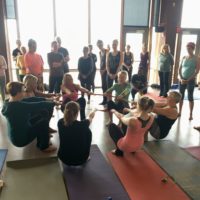Pleasure Meter
The Pleasure Meter is a good activity to start discussion early in a program, but not right at the beginning. It acquaints participants with each other, indicates preferences and lets us find out about the other members of our group. It can help you learn about the participants and may help your group define sexual behavior. As you discuss pleasure and then sex, encourage the group to include sex by yourself as sex, discuss roadblocks like health, culture, shame and religion.
With one Raccoon Circle, make an arc shape like the one shown here. This is your pleasure meter. Ask participants to stand along the edge of the meter, at the position that best relates to them. For example, the amount of pleasure that you have right now could be just like a gas tank gauge (empty, half a tank, full). Then have them move along the edge according to the amount of pleasure the following types of people “should have;” you don’t need to do all of them. And don’t define “pleasure.”
- Infant
- Toddler
- Pre-school-age child
- Kindergartner
- Grade school student
- Child with ADD
- Someone in a wheelchair
- Middle school student
- High school student
- College student
- Someone in their 20’s
- Pregnant woman
- People in their 30’s and 40’s
- Retired people
- People in nursing homes
- Octogenarians
- Geezers
As the group arranges itself along the meter, ask them questions about:
- What are you thinking about when I say pleasure?
- What are some roadblocks to feeling pleasure?
- Where do you get pleasure?
- Why do red flags go up when we connect pleasure with certain groups?
- How do you define pleasure?
- Think of an activity you consider pleasurable–would you answer the phone when you are doing this activity?
- What would you put on a “Pleasure Menu?”





